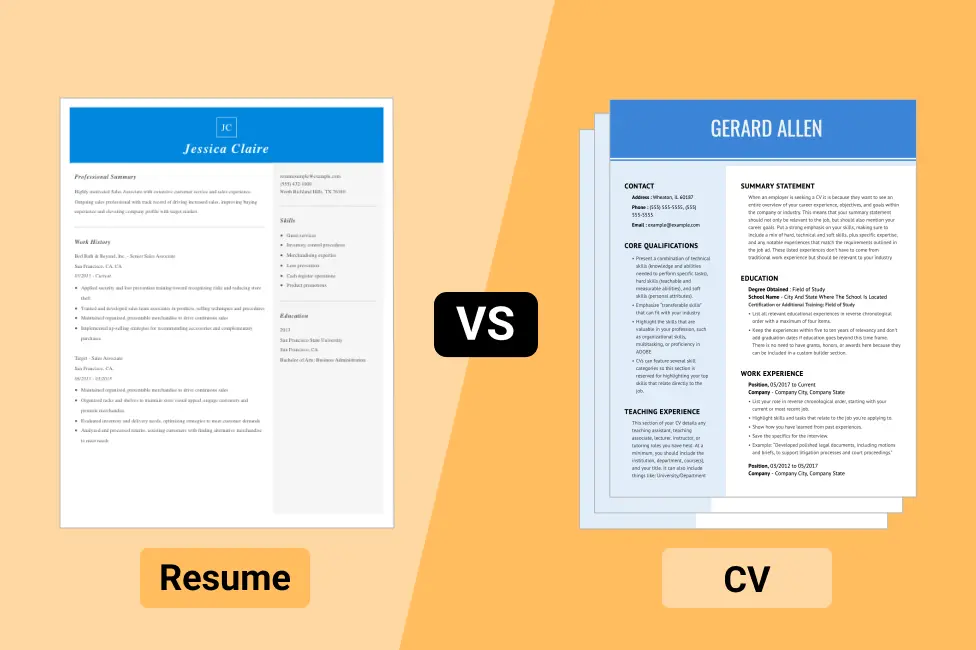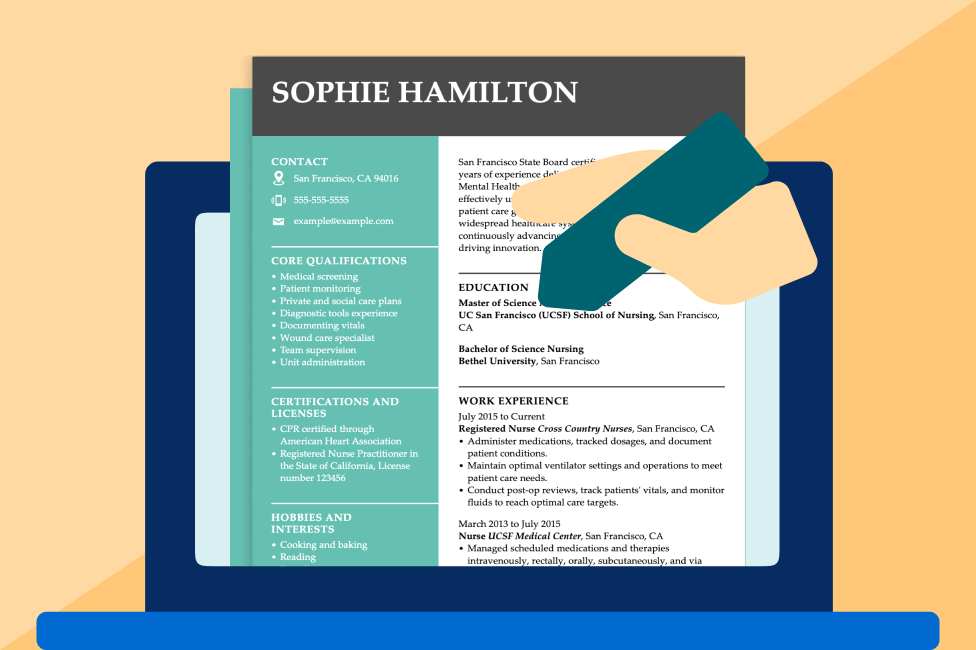Academic CV Examples Writing Guide
Our academic CV examples will help you land that coveted academic or research position. With our writing tips, you’ll learn how to format CV sections and showcase relevant achievements.
Academic CV example
This academic CV example for research shows you the standard CV template that employers in research or academia expect to see. Notice how the professional profile and achievements are tailored to the job seeker’s desired role. Personalizing your CV is key to landing a job interview and our CV examples will help you achieve this easily.
How to write an academic CV
An academic curriculum vitae (CV) is a comprehensive document highlighting your academic achievements, research endeavors, teaching experiences and professional qualifications. The academic CV is ideal for anyone applying for an academic job, however, if you’re planning to use a CV for college admissions, you can check out our How to Write a College Resume article for more tailored advice.
When writing a CV, there are some key sections you should always include and optional sections you can add according to your professional experience.
Academic CV sections:
- Contact information
- CV summary or CV objective
- Education
- Professional appointments
- Teaching experience
- Research experience
- Skills
- Publications
- Awards and Honors
- Grants and Fellowships
- Conferences
- Professional affiliations
- Additional training
- References
What you include in your academic CV doesn’t need to be every section listed above. However, our guide will teach you to write each section with practical examples so you can pick and choose according to your needs.
However, if you’d like help writing your CV, use our CV Maker. It comes equipped with 25+ CV designs, industry-specific content you can customize and a CV check to ensure your document is error-free and beats applicant tracking systems (ATS).
Whatever your preferred method, crafting an effective academic CV requires careful attention to detail and a strategic approach. Therefore, here’s a step-by-step guide on how to write an academic CV, along with examples for each potential section:
1. Contact Information
Begin your academic CV by providing your contact details for easy communication. Include the following:
- Your full name
- Phone number
- Email address
- City and state
Example:
Lindsay Carter
(555) 555-5555 | example@livecareer.com | Reno, NV
You can add more relevant information to your contact by including:
- Any postnominal abbreviations, i.e., Ph.D., Psy.D., J.D.
- Your LinkedIn profile
- Links to your Google Scholar Profile, ORCID or portfolio
2. CV summary or objective
Every CV should include a section where you introduce yourself to potential employers by sharing your most relevant qualifications and stating your career goals. In an academic CV, this section can be a professional summary or a research objective.
A CV summary will provide a straightforward and tailored selection of qualifications most relevant to the role you are applying, such as:
- years of experience
- areas of expertise
- skills
- and a unique, impressive achievement to capture employers’ attention
A CV research objective is similar, but it adds another layer of personalization by stating your professional objectives as a researcher as it pertains to this post. Therefore, researchers just starting, with limited experience, would benefit greatly from this approach.
Check out the following examples of a CV summary and a CV objective to better determine the right approach for you:
Summary – Academic CV for a post-doctoral position
“Experienced postdoctoral researcher specializing in anthropology, dedicated to conducting innovative research and publishing impactful findings. Proficient in ethnography and postcolonial and feminist theories, with expertise in gender and identity politics within Yoruba communities in Africa and the diaspora. Skilled in interdisciplinary collaboration and adept at data analysis and manuscript preparation. Seeking a postdoctoral position to further research goals, mentor students, and contribute to the scholarly community at the University of Cambridge.”
Research Objective – Academic CV for a Ph.D. application
“Passionate and dedicated historian committed to advancing knowledge in Ancient Greece through interdisciplinary research and critical inquiry. With a strong foundation in historical methods and theory, my research interests lie at the intersection of politics and religion. I aim to explore how political leaders utilized mythology to inform their political decisions, shedding new light on how religious practices have intervened in political decision-making. As a doctoral candidate at Brown University, I aspire to contribute to the vibrant intellectual community, engage in collaborative scholarship, and produce rigorous and innovative research that contributes to historical scholarship and public discourse.”
3. Education
When listing your academic CV’s education section, list your academic qualifications, starting with your most recent degree. For each degree, you’ll want to include:
- The degree earned
- Institution attended
- Location of the college/university
- Any relevant honors or awards
Here’s an example of an academic CV’s education section:
Education
Doctor of Philosophy (Ph.D.) in English Literature
Oxford University – Oxford, United Kingdom
Dissertation Title: “Exploring Narrative Structures in Modernist Literature”
Master of Arts (M.A.) in English Literature
University of Cambridge – Cambridge, United Kingdom
Thesis Title: “Interpreting Symbolism in Shakespearean Tragedies”
Bachelor of Arts (B.A.) in Literature
Harvard University – Cambridge, Massachusetts, U.S.
Thesis Title: “Cross-Cultural Perspectives in Postcolonial Literature”
4. Professional appointments
This academic CV section functions as work experience where you showcase exclusively academic positions, so leave out any unrelated jobs from this section.
For each professional appointment you list, you must include:
- Your title
- Name of the institution (university, research institute, etc.)
- Name of the department
- Employment dates
- A brief description of your duties and achievements
Here’s how a professional appointments section entry would look like:
Assistant Professor of History
Department of History, University of Miami, Miami, FL
Start Date: Aug 2021 – Present
Responsibilities:
- Teach undergraduate and graduate courses in Caribbean history, diaspora studies, and postcolonial theory.
- Conduct original research on disaster politics in 1920s Puerto Rico.
- Advise undergraduate and graduate students on research projects and academic pursuits.
- Serve on departmental committees and participate in academic governance.
5. Teaching experience
The teaching experience section in an academic CV slightly differs from the “Professional appointments.” Where the professional appointments section is reserved for academics and researchers with ample experience in formal academic posts, the teaching experience is optional for less experienced candidates to showcase their experience as teaching assistants (TA).
Here’s an example of how to list your teaching experience in an academic CV:
Teaching Assistant
Department of Mathematics, The University of New Mexico, Albuquerque, NM
Start Date: Jan 2018 – May 2023
Responsibilities:
- Assisted in teaching undergraduate courses in Calculus I and II.
- Conducted tutorial sessions, graded assignments, and provided feedback to students.
- Led problem-solving sessions and facilitated group discussions to reinforce course concepts.
6. Research experience
In your academic CV’s research experience section, highlight any research projects you’ve undertaken, including the project title, your role and a brief description of your contributions. All research posts are valid: full-time researcher, research associate and research assistant.
Check out this CV research experience section entry example:
Research Assistant, Department of Economics, University of Michigan, Ann Arbor, MI (Aug 2022 – Present)
- Conducted research on the impact of globalization on income inequality.
- Analyzed large datasets using advanced statistical methods such as econometric modeling, regression analysis, and time series analysis to identify trends and patterns in economic indicators.
- Presented findings at the International Economic Conference 2023.
7. Skills
Your academic CV can also benefit from a skills section where you list key knowledge necessary for the position you’re applying for. Showcase relevant hard and technical skills such as research methodologies, data analysis techniques, programming languages or other technical proficiencies.
8. Publications
As an academic, having a strong list of publications is one of the best ways to build your research’s credibility and relevance. When writing your academic CV’s “Publications” section, list your academic writings, including journal articles, book chapters and conference papers. Include publication titles, authors, dates and relevant links if available.
Here’s an example of how an academic CV publications citation would look:
9. Awards and Honors
A section that can help prop up your candidacy for an academic role is “Awards and Honors.” Aim to list awards, scholarships, fellowships, grants and other honors you have received throughout your academic and professional career.
Be sure to include:
- Name of the award
- Granting institution or organization
- Date received
- Relevant details or achievements associated with each award
Here’s an example of an academic CV’s “Awards and Honors” entry:
Outstanding Teaching Assistant Award
- Department of Social Sciences, Tulane University, New Orleans, LA
- 2023
- Recognized for excellence in teaching and mentoring undergraduate students, based on student evaluations and faculty recommendations.
10. Grants and Fellowships
An academic CV wouldn’t be complete without a section showcasing the grants or fellowships you’ve received because of your academic excellence. Include the funding body, project title, duration and amount awarded.
Here’s an example of how to present your grants and fellowships in an academic CV:
Research Grant Recipient, Howard University Graduate Research Fund
Project Title: “Exploring Sustainable Development Strategies”
Duration: 12 months | Amount: $10,000
11. Conferences
The “Conferences” section of your academic CV should list any conferences, symposiums, workshops or seminars where you have presented your research findings or participated as an attendee.
Include the full title of the conference, the name and location of the hosting organization, the date of the conference and your role (e.g., presenter, panelist, attendee). If you presented research at the conference, provide the title of your presentation and any relevant details.
Example:
American Economic Association Annual Meeting
- American Economic Association (AEA), Chicago, Illinois, U.S.
- January 2023
- Presented paper titled “Impact of Trade Policies on Income Inequality: Evidence from Developing Countries” in the session on International Trade and Development.
12. Professional Affiliations
The “Professional Affiliations” section of your academic CV should list any professional organizations, societies or associations you are a member of within your field of study. Include the full name of the organization, your membership status (e.g., member, fellow) and any leadership roles or committee memberships you hold.
Here’s an example:
American Anthropological Association (AAA)
- Member since 2020
- Secretary, Graduate Student Chapter, 2021-2022
13. Additional training
The “Additional Training” section is an optional addition to your academic CV where you list any relevant workshops, seminars, courses, certifications or other forms of continuing education that enhance your skills and qualifications.
When listing this additional training, include:
- Title of the training program
- Name of the institution or organization that provided the training
- Completion date
- Brief descriptions of what you learned
Check out this example:
Research Ethics Training
- Institutional Review Board (IRB), CITI Program
- Date Completed: March 2021
- Completed training on research ethics principles, human subjects protection regulations and ethical considerations in research.
14. References
Another optional section for your academic CV is a list of references. Include a list of individuals (professors, mentors, colleagues, supervisors) who can vouch for your academic or professional credentials. Remember to obtain permission from each reference before including their contact information.
Here’s how to list references in an academic CV:
Dr. Jennifer Pascal
Professor of Economics
University of Delaware
j.pascal@udelaware.com | (123) 456-7890
Writing an academic CV does require a bit of effort, but making a compelling and well-formatted curriculum vitae is much more convenient when you use our CV Maker. Because CVs are highly customizable, we’ve included the option to add as many additional sections as you need without affecting the required formatting academic employers expect. By simply inputting your desired job title, our CV Builder will write a personalized curriculum vitae in minutes!
Tips for writing a standout academic CV
Every year, Ph.D.s outnumber the amount of tenured positions available for job seekers in academia. Therefore, if you want your academic CV to make a strong impression, you must do more than choose the right sections. Follow these tips to ensure your CV exceeds employers’ expectations:
- Tailor your qualifications to fit the job requirements: Analyze the job description carefully and choose to highlight relevant skills, experiences and accomplishments that match the employer’s specific requirements and needs.
- Utilize action verbs at the beginning of each sentence: Begin each bullet point in your CV with strong action verbs like “developed,” “analyzed” and “implemented,” which showcase your active role in projects and endeavors.
- Use appropriate fonts, line spacing and margins: Choose a professional font like Arial or Georgia in sizes between 10 and 12. Ensure your margins are one inch and even on all sides. For line spacing, aim for 1.15 to 1.5 for better readability.
- Organize your accomplishments in reverse-chronological order: Arrange your achievements, publications and experiences in reverse-chronological order, starting with the most recent entries. This format allows employers to assess your latest accomplishments and successes quickly.
- Vary font styles to break up monotony: Incorporate bold or italic font styles to highlight key information, such as section headings, job titles or significant achievements. Varying font styles help to draw attention to key information without straying away from a professional and appropriate academic CV format.
- Avoid super technical jargon: Use clear and concise language, and avoid overly technical jargon that may be unfamiliar to non-specialists. When using acronyms, always provide the full term on the first mention to ensure clarity and understanding for all readers.
- Make good use of white space to balance the page: Maintain adequate white space between sections and bullet points to prevent overcrowding your academic CV. Balancing text and “empty space” creates a visually appealing layout that guides the reader’s eye smoothly through the document.
More academic CV examples
Browse these academic CV examples for the CV sample that matches your desired job title. Edit your preferred CV example, and get ready to land interviews!
Graduate school
Professor
Artist
Principal
Teaching Assistant
Historian
Librarian
Research assistant
Intern
FAQ
How long should an academic CV be?
The length of your academic CV will vary depending on your experience level, the requirements of your desired position, and the institution you are applying to. Academic CVs are longer than resumes and can range from 2 to 10 pages or more. However, it’s essential to prioritize relevance and conciseness. Include all pertinent information about your academic and professional achievements, but avoid unnecessary details or padding.
Do I need an academic CV for graduate school?
Yes, most graduate school applications require a CV as part of the application package. A CV allows you to showcase your academic background, research experience, publications, presentations, awards and other relevant achievements. A strong academic CV will provide admissions committees with a comprehensive overview of your qualifications and help them assess your suitability for the program.
What is the difference between a resume and a CV?
While resumes and CVs (curriculum vitae) are documents used to summarize your qualifications and experiences, they serve different purposes and have distinct formats:
- Resume: Typically used in non-academic settings and for job applications in industries such as business, healthcare or technology. Resumes are concise, usually one to two pages long, and focus on highlighting relevant skills, work experience and accomplishments. They are tailored to specific job positions and emphasize transferable skills and achievements.
- CV (Curriculum Vitae): Commonly used in academia, research and specific professional fields like entertainment, sports and medicine. CVs are more comprehensive than resumes and tend to be longer, ranging from two to several pages. CVs detail academic qualifications, research experience, publications, presentations, teaching experience, grants, awards and other relevant information. They offer a comprehensive overview of an individual’s academic and professional background and are regularly updated to reflect ongoing achievements and contributions.






